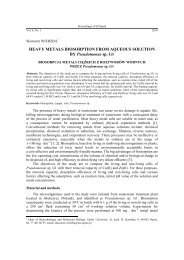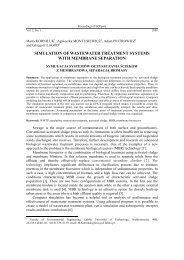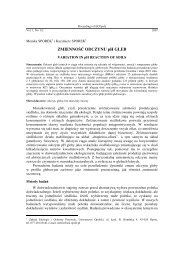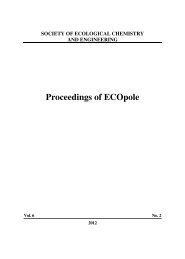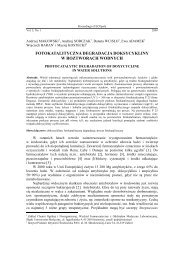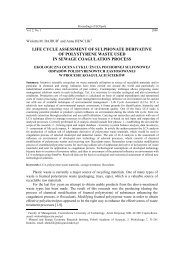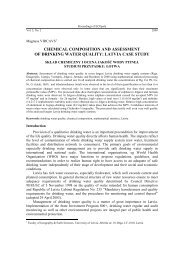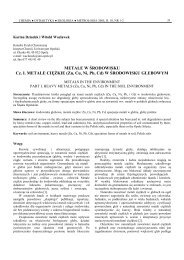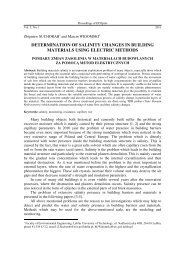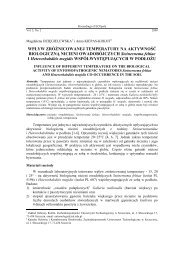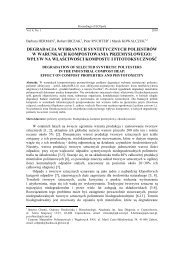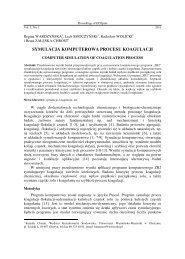Download part 3 of the issue - Uniwersytet Opolski
Download part 3 of the issue - Uniwersytet Opolski
Download part 3 of the issue - Uniwersytet Opolski
Create successful ePaper yourself
Turn your PDF publications into a flip-book with our unique Google optimized e-Paper software.
348<br />
Literatura<br />
Lidia Dąbek, Ewa Ozimina i Anna Picheta-Oleś<br />
[1] Świderska R, Czerwińska M, Kutz R. Utlenianie zanieczyszczeń organicznych za pomocą odczynnika<br />
Fentona. VII Ogólnopolska Konferencja Naukowa Kompleksowe i szczegółowe problemy inżynierii<br />
środowiska. Zesz Nauk Polit Koszalin. 2005;22:1-12.<br />
[2] Wąsowski J, Piotrowska A. Rozkład organicznych zanieczyszczeń wody w procesach pogłębionego<br />
utleniania. Ochr Środow. 2002;2:27-32.<br />
[3] Barbusiński K. Oczyszczanie ścieków przemysłowych metodami katalitycznymi z wykorzystaniem<br />
nadtlenku wodoru. Chemik. 2001;2:31-36.<br />
[4] Gupta VK, Suhas V. Application <strong>of</strong> low-cost adsorbents for dye removal - A review. J Environ Manage.<br />
2009;90:2313-2342.<br />
[5] Bansal RCh, Goyal M. Activated Carbon Adsorption. Boca Raton-London-New York-Singapore: Taylor &<br />
Francis Group; 2005.<br />
[6] Santos VP, Pereira MFR, Faria PCC, Órfão JJM. Decolourisation <strong>of</strong> dye solutions by oxidation with H2O2 in<br />
<strong>the</strong> presence <strong>of</strong> modified activated carbons. J Hazard Mater. 2009;162:736-742.<br />
[7] Toledo LC, Silva ACB, Augusti R, Lago RM. Application <strong>of</strong> Fenton’s reagent to regenerate activated carbon<br />
saturated with organochloro compounds. Chemosphere. 2003;50(8):1049-1054.<br />
[8] Huang HH, Lu MC, Chen JN, Lee CT. Catalytic decomposition <strong>of</strong> hydrogen peroxide and 4-chlorophenol in<br />
<strong>the</strong> presence <strong>of</strong> modified activated carbons. Chemosphere. 2003;51(9):935-943.<br />
[9] Dąbek L, Ozimina E, Picheta-Oleś A. Sorptive and catalytic properties <strong>of</strong> activated carbon used for <strong>the</strong><br />
removal <strong>of</strong> crystal violet from an aqueous solution in <strong>the</strong> presence <strong>of</strong> hydrogen peroxide. Ecol Chem Eng A.<br />
2010;17(11):1423-1433.<br />
[10] Mourand JT, Crittenden JC, Hand DW, Perram DL. Notthakun S. Regeneration <strong>of</strong> spent adsorbents using<br />
homogeneous advanced oxidation. Water Environ Res. 1995;67(3):355-363.<br />
[11] Vidic RD, Suidan MT, Sorial GA, Brenner RC. Effect <strong>of</strong> molecular oxygen on adsorptive capacity and<br />
extraction efficiency <strong>of</strong> granular activated carbon for three ortho-substituted phenols. J Hazard Mater.<br />
1994;38:373-388.<br />
APPLICATION OF COMBINED PROCESSES OF SORPTION<br />
AND OXIDATION FOR THE REMOVAL OF p-CHLOROPHENOL<br />
FROM THE AQUEOUS ENVIRONMENT<br />
Faculty <strong>of</strong> Civil and Environmental Engineering, Kielce University <strong>of</strong> Technology<br />
Abstract: In this paper <strong>the</strong> effectiveness <strong>of</strong> removing p-chlorophenol from <strong>the</strong> aqueous solution as a simulation <strong>of</strong><br />
removing highly soluble chloroorganic compounds (being one <strong>of</strong> <strong>the</strong> most dangerous pollutants) has been<br />
examined. The following processes have been selected as <strong>the</strong> removal methods: sorption, oxidation with hydrogen<br />
peroxide and Fenton reagent as well as simultaneous sorption and oxidation with hydrogen peroxide. It has been<br />
proven that <strong>the</strong> hydrogen peroxide does not oxidate p-chlorophenol, while in <strong>the</strong> Fenton reaction an immediate<br />
decomposition <strong>of</strong> this substance takes place. It has been established that <strong>the</strong> sorption <strong>of</strong> activated carbon is<br />
an effective method <strong>of</strong> removing p-chlorophenol from an aqueous solution. Additionally, <strong>the</strong> used activated carbon<br />
may be successfully regenerated by oxidating <strong>the</strong> adsorbed substance with hydrogen peroxide or Fenton reagent<br />
and used again as a sorbent. However, <strong>the</strong> discussed process leads to a substantial loss <strong>of</strong> activated carbon<br />
as a result <strong>of</strong> its oxidation. The more effective solution is removing p-chlorophenol from <strong>the</strong> aqueous solution<br />
by oxidation with Fenton reagent or hydrogen peroxide in <strong>the</strong> presence <strong>of</strong> activated carbon. In such conditions<br />
both sorption and oxidation <strong>of</strong> organic substances present in <strong>the</strong> aqueous solution and adsorbed on <strong>the</strong> activated<br />
carbon take place, which also leads to <strong>the</strong> regeneration <strong>of</strong> <strong>the</strong> activated carbon and allows for its fur<strong>the</strong>r use.<br />
Keywords: activated carbon, oxidation, sorption, hydrogen peroxide, p-chlorophenol



